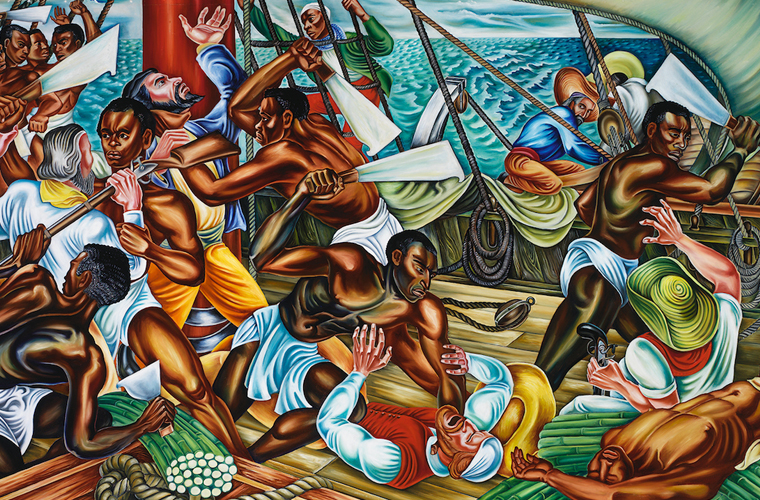Slave ships were designed and equipped to deal with African resistance. From the earliest days of the trade, it was obvious that African captives, terrified though they were, would seize any opportunity to free themselves. Africans sought to escape even before they reached the coast, running away from their captors when possible. On board a ship, however, escape became more difficult. While the slave ship was anchored on the coast, European sailors loaded captives sporadically until the ship was filled, or it was time to sail.
The slave ship crew separated the men from the women and children when they were detained in the forts, castles, and coastal barracoons. This process of separating African captives by gender continued on the slave ships. The first Africans brought on board may have been allowed a degree of freedom of movement. As the number of captives increased, however, and the crew was greatly outnumbered, the ship became a floating prison. It was then that the crew used chains, manacles, and padlocks produced by tradesmen in Europe to shackle mainly the adult males, who were kept in batches and locked below decks as the number of captives increased. Generally, the women and children had more freedom of movement and were not shackled together unless they formed a threat to the crew.
Despite the chains, shackles, and other repressive equipment of imprisonment carried by the captain and crew on all slave ships, Africans found ways of resisting. The weeks or months spent on the African coast, waiting as the ship filled with slaves, was a dangerous period for the crew. When the Africans were in sight of their land, and with boats passing to and fro between the ship and land carrying captives, open resistance was common. Approximately one slave ship in ten experienced some form of African resistance, and the rate was much higher for vessels embarking captives in Senegambia, which had the highest incidence of shipboard rebellion of any African region.
Shipboard resistance ranged from an individual act of defiance—an isolated act of violence, or a (normally fatal) attempt to leap overboard—to major revolts which descended into a life-and-death struggle between Africans and sailors. For example, the enslaved people aboard the Clare mutinied and successfully drove the crew from the vessel, landing and liberating themselves near Cape Coast Castle on the Gold Coast in 1729.
Sometimes an onboard insurrection resulted in the death of the enslaved and their captors, as was the case with one slave ship with a crew based in Newport, Rhode Island, in 1785. Rebellions could sink ships, as the result of a major explosion or fire. More likely, however, African rebels were beaten back by the superior firepower and violence of the crew. Slave ships were designed to give the crew vantage points to bring their weaponry to play against the Africans. Other ships and men of the shore rallied to fight against rebellious Africans, and gory defeat was commonplace. Once defeated, African rebels were subjected to a ritual of grisly punishments and execution, all designed to illustrate to survivors (and to Africans watching on neighboring ships) the inevitable fate of defeated rebels.
Faced with the permanent threat of African resistance, the crew had to be permanently alert. A piece of wood, a tool, or any physical object carelessly left within a slave’s reach, could become a weapon. Even African children were distrusted by the crew, as they could pass dangerous objects to the men chained below the deck to facilitate escape and revolt.
From the early days of the trade, though Europeans considered the Africans a profitable cargo, they were also a threat and a danger. The crew on all slave ships were outnumbered—often by a significant margin. Their control could not be maintained, and the voyage was completed, without a reliable and violent means of keeping the ranks of Africans under control. Thus, to ensure the successful landing of their African captives, the crew used a repressive system of imprisonment, chains, and of guns aimed at the slave decks. Such a system, the sailors realized, was required to combat the threat to their lives from possible African rebellion.
Scholars do not know how many Africans died in slave ship rebellions: they were numbered among the more than one million Africans who did not survive the Atlantic crossing. Most shipboard fatalities were caused by diseases and illness. The eleven million survivors entered the Americas physically and emotionally traumatized by the slave ship experience, by disease and suffering, by the deaths around them, and by the inescapable threat of the captain and crew. Through faith and resilience, Africans began making new worlds for themselves and their new communities, within the bounds of American societies bent on their coercion.

